In a world where smart devices, embedded systems, and IoT permeate every aspect of our lives, hardware security is just as crucial as software and network protection. Physical attacks represent a growing threat, exploiting vulnerabilities directly in electronic components and putting everything at risk—from cryptographic keys to sensitive data. In this article, we dive deep into this realm, discussing the techniques attackers use, the categories of attacks, and the best practices for safeguarding your devices.
What Are Physical Attacks?
Physical attacks involve directly exploiting hardware vulnerabilities. Unlike traditional cyberattacks that exploit software and network loopholes, these methods require physical or near-physical access to the device. An attacker can gather information by measuring voltage, current, operating time, or even electromagnetic emissions to recover secrets such as cryptographic keys and design details.
These attacks typically unfold in two main phases:
- Interaction Phase: The attacker physically interacts with the device using specialized equipment to collect data.
- Exploitation Phase: After data collection, the attacker analyzes the signals or images to reveal sensitive information and compromise system security.

Categories of Physical Attacks
Physical attacks can be divided into three main categories, each with its unique techniques, costs, and risks:
1. Invasive Attacks
Invasive attacks require direct access to the device’s internal components, typically by dismantling the chip to expose its integrated circuit.
- Techniques Used:
- Decapsulation: Removing the chip’s package to expose the silicon.
- Reverse Engineering: Using optical microscopes and high-resolution cameras to capture images of each chip layer.
- Microprobing: Microprobing stations allow submicron-level access to internal buses to monitor or inject test signals.
- Applications: Extracting secret keys, modifying the chip, or reconfiguring it to create cloned versions.
- Characteristics: High cost and complexity; invasive methods are usually irreversible and can cause permanent damage to the system.
2. Semi-Invasive Attacks
Semi-invasive attacks combine elements of both invasive and non-invasive methods. Although the chip’s package is still removed, the attacker does not directly contact the internal signals.
- Techniques Used:
- Imaging Techniques: Utilizing cameras and optical sensors to map the chip layout and identify active regions.
- Fault Injection: Injecting faults using laser beams, localized heating, or other physical alteration methods to change memory states.
- Applications: Modifying chip behavior without needing precise electrical contacts.
- Characteristics: Lower risk of damage compared to invasive attacks, but still requires investment in specialized equipment.
3. Non-Invasive Attacks
Non-invasive attacks focus on gathering information without causing physical damage to the device, maintaining its structural integrity.
- Techniques Used:
- Side-Channel Analysis: Measuring power consumption, electromagnetic emissions, or thermal variations to deduce internal operations.
- Organized Brute Force: Systematically searching for passwords or keys by exploiting predictable memory addressing patterns.
- Glitches: Inducing rapid variations in power or clock signals to trigger temporary errors in the chip’s processing.
- Applications: Extracting data without dismantling or physically altering the chip.
- Characteristics: Generally lower cost, these methods can be carried out without leaving obvious signs of tampering, making detection more challenging.
Motivations and Examples of Physical Attacks
Physical attacks are often driven by financial gain, industrial espionage, or unfair competition. Key motivations include:
- Theft of Services and Money: Attacks on smart cards, gaming consoles, or set-top boxes aimed at direct fraud.
- Intellectual Piracy: Cloning circuits and stealing intellectual property, enabling the sale of illegal products.
- Access to Sensitive Data: Extracting cryptographic keys and confidential data that can be used for fraud or espionage.
Practical Examples
- Reverse Engineering and Microprobing: Used to map and reconstruct complex circuits, enabling the extraction of keys and sensitive data.
- Fault Injection via Glitches: Exploits variations in power or clock signals to induce processing errors and undermine cryptographic algorithms.
- Side-Channel Attacks: Monitoring power consumption to infer internal operations and reveal confidential information during normal chip operation.
Strategies and Countermeasures to Protect Hardware
Given the increasing sophistication of physical attacks, manufacturers and security experts need to adopt a multifaceted approach to protect devices. Here are the key countermeasures:
1. Encryption and Bus Scrambling
- Advanced Encryption: Even if an attacker gains physical access to the device, robust encryption makes it difficult to extract and misuse the information.
- Bus Scrambling: Altering the order of data transmission between the CPU and memory prevents attackers from easily identifying critical data buses.
2. Integrated Design and Glue Logic
- Glue Logic Design: Instead of using standard, predictable components, this technique integrates functionalities such as registers, decoders, and arithmetic units into a single design, making it harder to identify data paths.
- Sensor Mesh: Modern devices, such as smart cards, incorporate a sensor mesh in the top metal layer that detects microprobing attempts, triggering alarms and automatically erasing sensitive data.
3. Continuous Auditing and Updates
- Security Testing: Regular audits and physical attack simulations help identify vulnerabilities before they can be exploited.
- Firmware and Software Updates: Keeping firmware and software up-to-date is essential for patching vulnerabilities that could be exploited in non-invasive attacks.
Conclusion
Hardware security is a complex and ever-evolving challenge, demanding an integrated approach to counter physical attacks. By understanding the various techniques—from reverse engineering and microprobing to fault injection and side-channel analysis—it is possible to develop robust countermeasures that protect devices against intrusions. Investing in advanced encryption, innovative design, and continuous security audits not only hinders attackers but also strengthens customer trust and system integrity.
In a landscape where the risks and costs of an attack can be enormous, proactive prevention and constant updating of security practices are essential. Stay informed about the latest trends and innovations in hardware security, and adopt proactive strategies to keep your systems safe from physical threats.
To further deepen your understanding of hardware security, check out our article “Physical Attacks: Unveiling Hardware Security Threats”. In it, we explore various physical attack techniques and effective countermeasures, complementing the defense strategies discussed here.





